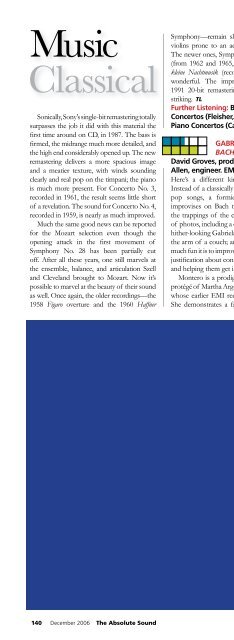You also want an ePaper? Increase the reach of your titles
YUMPU automatically turns print PDFs into web optimized ePapers that Google loves.
Music<br />
Classical<br />
Sonically, Sony’s single-bit remastering totally<br />
surpasses the job it did with this material the<br />
first time around on CD, in 1987. The bass is<br />
firmed, the midrange much more detailed, and<br />
the high end considerably opened up. The new<br />
remastering delivers a more spacious image<br />
and a meatier texture, with winds sounding<br />
clearly and real pop on the timpani; the piano<br />
is much more present. For Concerto No. 3,<br />
recorded in 1961, the result seems little short<br />
of a revelation. The sound for Concerto No. 4,<br />
recorded in 1959, is nearly as much improved.<br />
Much the same good news can be reported<br />
for the Mozart selection even though the<br />
opening attack in the first movement of<br />
Symphony No. 28 has been partially cut<br />
off. After all these years, one still marvels at<br />
the ensemble, balance, and articulation Szell<br />
and Cleveland brought to Mozart. Now it’s<br />
possible to marvel at the beauty of their sound<br />
as well. Once again, the older recordings—the<br />
1958 Figaro overture and the 1960 Haffner<br />
Symphony—remain slightly grainy, with the<br />
violins prone to an acidulous edge in forte.<br />
The newer ones, Symphonies Nos. 33 and 28<br />
(from 1962 and 1965, respectively) and Eine<br />
kleine Nachtmusik (recorded in 1968), sound<br />
wonderful. The improvement over Sony’s<br />
1991 20-bit remastering of this material is<br />
striking. TL<br />
Further Listening: Brahms: Piano<br />
Concertos (Fleisher, Szell); Mozart:<br />
Piano Concertos (Casadesus, Szell)<br />
Gabriela Montero:<br />
Bach and Beyond.<br />
David Groves, producer; Jonathan<br />
Allen, engineer. EMI 64647.<br />
Here’s a different kind of crossover CD.<br />
Instead of a classically trained singer trashing<br />
pop songs, a formidable classical pianist<br />
improvises on Bach themes. It comes with<br />
the trappings of the crossover genre: plenty<br />
of photos, including a cover showing a comehither-looking<br />
Gabriela Montero draped over<br />
the arm of a couch; an interview about how<br />
much fun it is to improvise; and the mandatory<br />
justification about connecting with audiences<br />
and helping them get into classical music.<br />
Montero is a prodigiously gifted pianist, a<br />
protégé of Martha Argerich and a prizewinner<br />
whose earlier EMI recital was well-received.<br />
She demonstrates a facile technique, sturdy<br />
tonal resources, and rhythmic zest. But what<br />
we have here is a Bach soufflé prepared by a<br />
Michelin-starred chef who whips a dollop of<br />
Bach, touches of Latin-American rhythms, a<br />
little Rachmaninoff, some Art Tatum, and a<br />
dash of silent-movie-style music into a neat<br />
dish of cocktail-lounge pianism that tickles<br />
the palate without satisfying the appetite.<br />
The pianist’s take on Jesu, Joy of Man’s Desiring,<br />
familiar from arrangements played by Lipatti,<br />
Kempff, and others, is nicely done but other<br />
slower works—such as her improvisation on<br />
the D minor keyboard concerto’s Adagio—<br />
feature an aimlessly languid lyricism that<br />
outlasts its interest. Typical of her freestyle<br />
approach is the Air from Suite No. 3, where<br />
140 December 2006 The Absolute Sound










